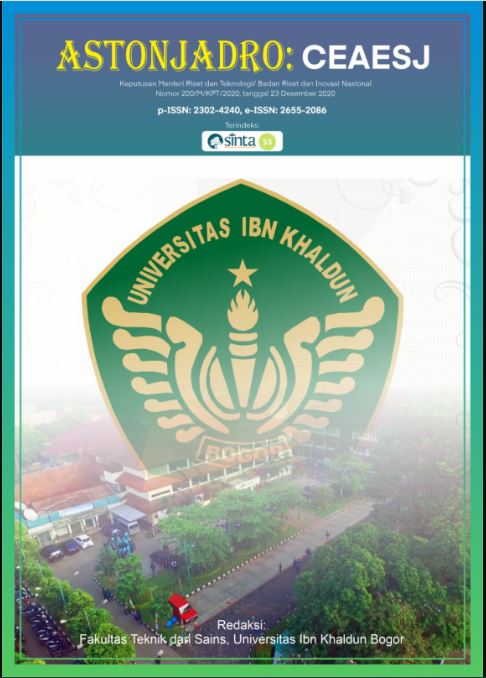THE EFFECT OF CALCIUM STEARATE USAGE IN SELF COMPACTING CONCRETE 20 MPA WITH PCC AND FLY ASH AS BINDERS TOWARD ON PULL OUT CAPACITY OF REINFORCEMENT
DOI:
https://doi.org/10.32832/astonjadro.v11i2.6216Keywords:
calcium stearate, pull out, self compacting concrete, corrosion attack.Abstract
Concrete is widely used for buildings because of its high compressive strength. Reinforced concrete must be able to withstand water infiltration into the concrete. This is to prevent the infiltration of corrosive ions with water that cause corrosion attacks on the reinforcement. One type of concrete that can reduce the infiltration of water into the concrete is Self Compacting Concrete (SCC). SCC generally uses a very small water cement ratio, so it can reduce water infiltration into the concrete. SCC is not enough to cover with corrosion attack significantly. The use of added calcium stearate has been shown to significantly reduce corrosion attack on concrete reinforcement. Unfortunately, the effect of calcium stearate usage on the bond strength of reinforcement and concrete has not been well studied. This study aims to determine the effect of calcium stearate on 20 MPa concrete with doses of 0, 1, 5 and 10 kg/m3 on the pull out capcity and failure pattern of the concrete. The tests carried out include the compressive strength test and the pull out capacity. The results showed that the average pull out capacity with the addition of calcium stearate 0, 1, 5, and 10 kg/m3 were 5.78, 4.08, 3.83, and 3.45 MPa, respectively. The type of failure that occurs when the maximum load is reached is a splitting failure.
References
Chari, M.N.; Naseroleslami, R.; and Shekarchi, M. 2019, The impact of calcium stearate on characteristics of concrete.Asian Journal of Civil Engineering, Vol. 20, 1–14.
Dzikri, M.; and Firmansyah., 2018. The Effect of Adding Superplasticizer to Copper Slag on the Compressive Strength of Concrete according to Age, Jurnal Rekayasa Teknik Sipil, Universitas Negeri Surabaya, Vol. 2, No. 2.
Ibragimov, R.; and Fediuk, R. 2019. Improving the early strength of concrete: Effect of mechanochemical activation of the cementitious suspension and using of various superplasticizer. Constuction Building Material, Vol. 226, 839–848
Maryoto, A.; Gan, B.S.; Hermanto, N.I.S.; and Setijadi, R., 2019. Infiltration of chloride ion in the self compacting concrete with calcium stearate, IOP Conf. Series: Materials Science and Engineering, Vol. 650 (2019).
Maryoto, A.; Gan, B.S.; Hermanto, N.I.S.; and Setijadi, R., 2019. Effect of Calcium Stearate in the Mechanical and Physical Properties of Concrete with PCC and Fly Ash as Binders, Materials, Vol. 13(1394).
National Standardization Bureau., 2013. SNI 2847:2013. Structural Concrete Requirements for Buildings. National Standardization Bureau, Jakarta.
Nawy, Edward, G., 1985, Reinforced Concrete. A Basic Approach, Translation by Bambang Suryoatmono, 1998, Second Edition. PT. Refrika Aditama, Bandung.
Putra, W.A.; Olivia, M.; and Saputra, E., 2020. Resilience of Portland Composite Cement (PCC) Concrete in the Peat Environment of Bengkalis Regency, Technical Journal, Vol. 14, No. 1, p. 27-34.
Quraishi, M.A.; Kumar, V.; Abhilash, P.P.; and Singh, B.N. 2011, Calcium stearate: A green corrosion inhibitor for steelin concrete environment. Journal of Material and Environmental Science,Vol. 2, 365–372.
Regulation of the Minister of Environment and Forestry of the Republic of Indonesia Number 18 of 2020. Utilization of Hazardous and Toxic Waste.
Regulation of the Minister of Environment and Forestry of the Republic of Indonesia Number 26 of 2020. Utilization of Hazardous and Toxic Waste.
Rusyandi, K.; Mukodas, J.; and Gunawan, Y., 2012. Design of Self Compacting Concrete with the Addition of Fly Ash and Structuro, Construction Journal of the Garut College of Technology, Vol. 10, No. 01.
Sendow, M.R.; Manalip, H; and Kumaat, E.J., 2018. Bonding Stress Between Steel and High Quality Concrete With Variations in Reinforcement Area, Journal of Static Civil, Vol. 6, No. 11, p. 1003-1010.
Shi, C.; He, T.; Zhang, G.; Wang, X.; and Hu, Y. 2016, Effect of superplasticizers on carbonation resistance of concrete. Constuction Building Material, Vol. 108, 48–55.
Umboh, A.H.; Sumajouw, M.D.J.; and Windah, S.R., 2014. The Effect of Use of Fly Ash from PLTU II North Sulawesi as a Partial Substitution of Cement on the Compressive Strength of Concrete, Journal of Static Civil, Vol. 2, No. 7, p. 352-358.
Yen, T.; Hsu, T.H.; Liu, Y.W.; and Chen, S.H. 2007. Influences of class F fly ash on the abrasion-erosion resistance of high-strength concrete. Constuction Building Material. Vol. 21, 458–463.
Downloads
Published
How to Cite
Issue
Section
License
Paper submitted to ASTONJADRO is the sole property of the Astonjadro Journal. Unless the author withdraws the paper because he does not want to be published in this journal. The publication rights are in the journal Astonjadro.ASTONJADRO
LICENSE
This work is licensed under a Creative Commons Attribution-ShareAlike 4.0 International License.
Based on a work at http://ejournal.uika-bogor.ac.id/index.php/ASTONJADRO













